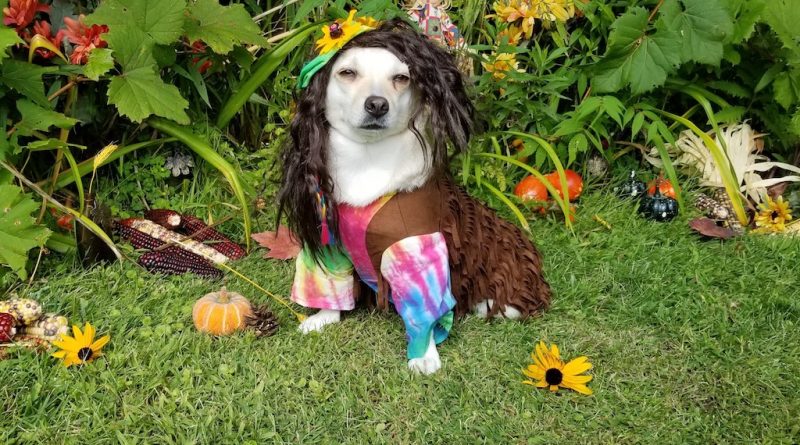Trick or Treat: Halloween Costumes are for Dogs, too!
By Karen Sturtevant, Guest Contributor
If you find yourself in New York City later this month, you may want to consider joining the throngs of dog lovers for the 29th Annual Tompkins Square Halloween Dog Parade. Pooches and their hoomans will strut their stuff while onlookers marvel at the creativity and silliness.
A costume contest for dogs, you say? Seriously? This is no passing fancy, events such like this are here to stay. Whether it’s for Instagrammable moments or just plain fun, it’s time to make (or order) that Superdog cape or tiny tie-dyed shirt and ponder the idea of entering the frenzy.
There was a time in my life when I may have poo-pooed (no pun intended) the idea of dressing up animals for fun. Not anymore and I’m not alone. The Guardian reports dog owners in the U.S. are estimated to spend $350 million (million!) each year on dressing up their furry friends.
Why would we do this? Is it strictly for our own enjoyment or do the dogs truly dig it too? Since our pups can’t speak, we can only observe and guess based on their reactions and behavior.

The truth is that clothing on animals isn’t natural but their love for us is. Dogs have an innate ability to feel our energy and read our moods. If we’re over-the-moon-excited, so are they. When we’re having a miserable day, they know. If we decide to jump into the costume crusade, we should remember a few rules that will keep Fido as comfortable and stress-free as possible.
1. Start Slowly
Since every dog’s tolerance level is different, introduction should be done gradually. While mine may tolerate a dreadlocked wig and hippy-fringed vest, yours may not. Try the costume on your pup for short periods of time weeks before Halloween––be gentle, no stuffing or forcing. Increase the time the costume is worn each day with praise, treats and kind words. The goal is to associate this new, foreign thing with pawsitive, warm fuzzies. If the dog is uncomfortable, take that cue and try again later.
2. Comfort Comes First
Any item, clothing or otherwise, should never inhibit the dog’s natural behavior. Apparel should be made with breathable, natural fibers, not synthetic, which may cause mobility restriction and hold in heat. Who wants to be around an overheated hot dog?
3. Spot the Signs of Stress
My little rescue dog approaches the world with caution. And yes, she will be wearing a costume this Halloween. That’s why we started our training in early September wearing it for a few minutes at a time. I’ve found it’s important to recognize the signs of canine stress: licking lips, refusing to move, rubbing and fussing, shaking and shivering, tucked tail, excessive barking or whining. If your pup is spooked by her costume, it may be time to remove it and try again another time.
4. Try Calming for Dogs
Another tool in our basket of tricks is Calming, a supplement for dogs (and cats, too) that helps with stress-related behavior problems. It helps pets calm down but doesn’t affect their personality or energy level. I keep it on hand for times when my girl needs a little assistance during uncomfortable situations.
5. Know When to Call it Quits
After a reasonable amount of effort, respect the signs from your dog whether it’s a thumbs up or thumbs way down of an idea. If you’ve got your heart (and camera phone) ready for your little one to sprout ladybug wings but she isn’t cooperating, it’s only fair to honor her feelings. A good back-up plan could be adding a stylish scarf, collar, harness or leash –– far less cumbersome and awkward.
Halloween is supposed to be fun not frantic. With some practical groundwork and realistic expectations, it can be a blast for you and your furry friend. Whether walking in a parade or greeting goblins at the door, this yearly celebration is another way to show our devotion and commitment to our little pumpkins.

